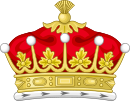| Earldom of Dundee | |
|---|---|
  | |
| Creation date | 1660 |
| Created by | Charles II |
| Peerage | Peerage of Scotland |
| First holder | John Scrymgeour, 3rd Viscount Dudhope |
| Present holder | Alexander Scrymgeour, 12th Earl of Dundee |
| Heir apparent | Henry David Scrymgeour-Wedderburn of that Ilk, Lord Scrymgeour |
| Subsidiary titles | Viscount of Dudhope Baron Glassary of Glassary, Argyll Lord Scrymgeour Lord Innerkeithing |
| Status | extant |
| Seat(s) | Birkhill |
Earl of Dundee is a title in the Peerage of Scotland. It was created in 1660 for John Scrymgeour, 3rd Viscount Dudhope. At his death in 1668, the Duke of Lauderdale declared that the first Earl had no heirs-male, and had the crown seize all of his lands. The earldom of Dundee became dormant and its holdings and offices were granted to Charles Maitland, 3rd Earl of Lauderdale, the Duke's younger brother. The title was revived in 1953, when it was determined that the first Earl did indeed have heirs-male, contrary to the assertion of the crown.[1] The title was given to Henry James Scrymgeour-Wedderburn, who had previously served in the House of Commons and in the Cabinet.
The Earl of Dundee holds the subsidiary titles: Viscount of Dudhope and Lord Scrymgeour, both created 1641 during the Bishops' Wars, when King Charles I was visiting Edinburgh. On the Restoration of Charles II, Lord Dundee received the additional title Lord Innerkeithing (created 1660). In 1954, the 11th Earl was created Baron Glassary of Glassary, Argyll. The first three titles are in the Peerage of Scotland and the Barony of Glassary is in the Peerage of the United Kingdom.
The eldest son and heir of the earl is addressed by a courtesy title as Lord Scrymgeour.
The family seat is Birkhill near Cupar, Fife.
- ^ Dudhope Peerage; Proceedings before the Committee for Privileges and Judgment. Sessional papers. Vol. HL 1951–52 IV (139) 325. UK Parliament. 28 October 1952. Retrieved 18 September 2020.